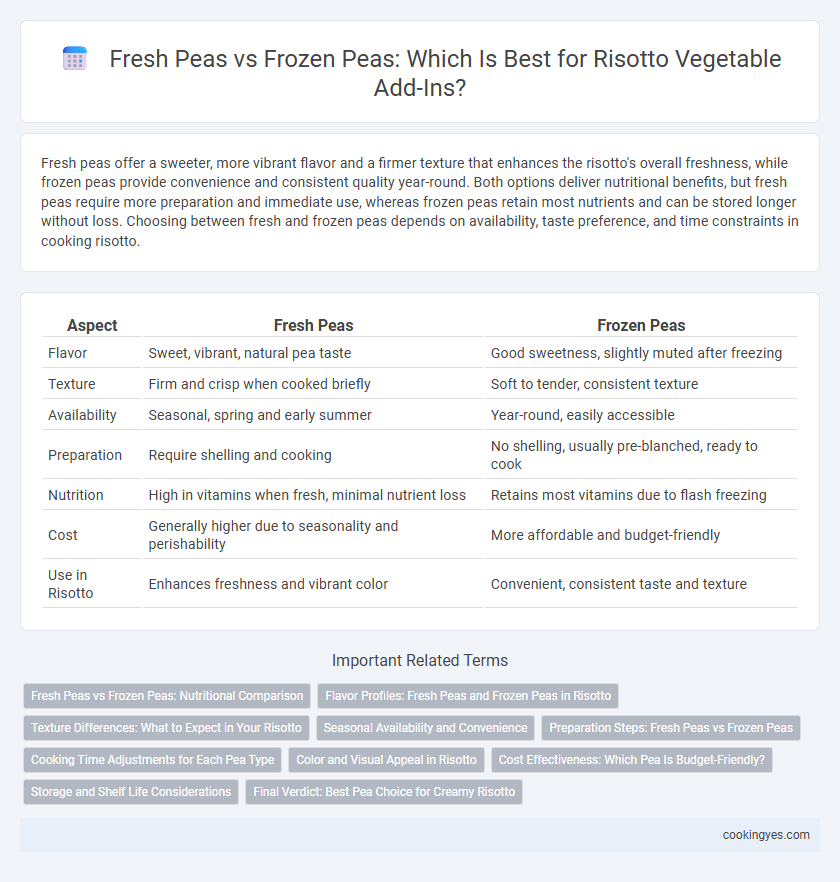Fresh peas offer a sweeter, more vibrant flavor and a firmer texture that enhances the risotto's overall freshness, while frozen peas provide convenience and consistent quality year-round. Both options deliver nutritional benefits, but fresh peas require more preparation and immediate use, whereas frozen peas retain most nutrients and can be stored longer without loss. Choosing between fresh and frozen peas depends on availability, taste preference, and time constraints in cooking risotto.
Table of Comparison
| Aspect | Fresh Peas | Frozen Peas |
|---|---|---|
| Flavor | Sweet, vibrant, natural pea taste | Good sweetness, slightly muted after freezing |
| Texture | Firm and crisp when cooked briefly | Soft to tender, consistent texture |
| Availability | Seasonal, spring and early summer | Year-round, easily accessible |
| Preparation | Require shelling and cooking | No shelling, usually pre-blanched, ready to cook |
| Nutrition | High in vitamins when fresh, minimal nutrient loss | Retains most vitamins due to flash freezing |
| Cost | Generally higher due to seasonality and perishability | More affordable and budget-friendly |
| Use in Risotto | Enhances freshness and vibrant color | Convenient, consistent taste and texture |
Fresh Peas vs Frozen Peas: Nutritional Comparison
Fresh peas contain higher levels of vitamin C and certain antioxidants due to minimal processing, whereas frozen peas retain most nutrients like fiber, vitamin K, and folate because they are typically flash-frozen shortly after harvesting. The freezing process preserves nutrient content effectively, making frozen peas a convenient alternative with comparable dietary fiber and protein levels to fresh peas. Overall, fresh peas may offer superior vitamin C content, but frozen peas provide excellent nutritional value with longer shelf life and less nutrient degradation.
Flavor Profiles: Fresh Peas and Frozen Peas in Risotto
Fresh peas offer a vibrant, sweet flavor with a delicate texture that enhances the creamy consistency of risotto, preserving their natural brightness when lightly cooked. Frozen peas retain much of their nutritional value and sweetness but have a slightly milder flavor and softer texture due to blanching before freezing, which can blend seamlessly into the dish. Choosing fresh peas intensifies the fresh, garden-like notes, while frozen peas provide convenience and consistent quality without sacrificing much taste.
Texture Differences: What to Expect in Your Risotto
Fresh peas provide a tender yet firm bite that maintains its shape and adds a vibrant burst of sweetness to risotto. Frozen peas tend to soften more during cooking, resulting in a creamier texture that blends smoothly into the dish. The choice impacts the risotto's overall mouthfeel, with fresh peas offering contrast and frozen peas delivering a more integrated consistency.
Seasonal Availability and Convenience
Fresh peas provide a vibrant, sweet flavor and tender texture ideal for spring and early summer risotto, but their availability is limited to peak growing seasons. Frozen peas offer year-round convenience without sacrificing significant taste or nutritional value, making them a reliable choice for risotto any time of the year. Choosing between fresh and frozen peas depends on balancing seasonal freshness with ease of preparation and consistent availability.
Preparation Steps: Fresh Peas vs Frozen Peas
Fresh peas require shelling and blanching before being gently folded into risotto to preserve their tender texture and vibrant color. Frozen peas are typically pre-blanched, allowing for a quicker addition directly into the risotto during the last minutes of cooking to maintain their sweetness and bright green hue. Both options enhance the dish, but careful timing in preparation ensures optimal texture and flavor integration.
Cooking Time Adjustments for Each Pea Type
Fresh peas require shorter cooking times in risotto, typically added during the last 5 minutes of simmering to maintain their tender texture and vibrant flavor. Frozen peas benefit from being stirred in a few minutes earlier, about 7-8 minutes before the end of cooking, allowing them to thaw and heat thoroughly without becoming mushy. Adjusting cooking time based on pea type ensures optimal texture and enhances the overall consistency of the risotto.
Color and Visual Appeal in Risotto
Fresh peas provide a vibrant green color that enhances the visual appeal of risotto, creating a bright and appetizing presentation. Frozen peas, while convenient, often have a duller hue due to blanching and freezing, which can result in a less vivid appearance in the final dish. Choosing fresh peas ensures a more striking contrast against the creamy risotto base, elevating the overall aesthetic quality.
Cost Effectiveness: Which Pea Is Budget-Friendly?
Frozen peas offer greater cost effectiveness for risotto due to their lower price and year-round availability compared to fresh peas, which tend to be more expensive and seasonal. Frozen peas retain most nutritional value and quality, making them a budget-friendly choice without sacrificing taste or texture. Choosing frozen peas reduces waste and ensures consistent supply, supporting economical meal planning.
Storage and Shelf Life Considerations
Fresh peas offer a bright, sweet flavor and tender texture but require immediate use or refrigeration for up to 2-3 days to maintain freshness in risotto. Frozen peas provide convenience and longer shelf life, typically lasting 8-12 months in the freezer while preserving nutrients and sweetness through flash freezing. Choosing between fresh and frozen peas impacts risotto preparation, with frozen peas ensuring consistent availability and fresh peas contributing to peak seasonal flavor.
Final Verdict: Best Pea Choice for Creamy Risotto
Fresh peas provide a naturally sweet flavor and tender texture that enhances the creaminess of risotto, but they require more preparation and seasonal availability limits use. Frozen peas maintain most nutritional value and sweetness while offering convenience and consistent quality year-round, making them ideal for quick cooking without compromising the dish's delicate balance. For creamy risotto, frozen peas deliver the best combination of texture, flavor retention, and ease, ensuring vibrant, fresh-tasting results regardless of season.
Fresh peas vs Frozen peas for vegetable add-in Infographic

 cookingyes.com
cookingyes.com